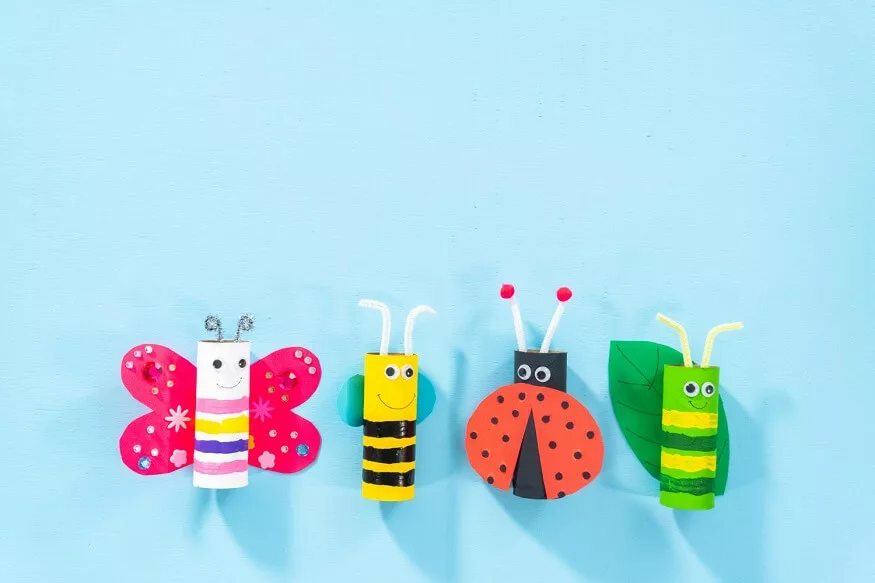Incorporating bug-themed crafts and activities not only sparks curiosity but also nurtures creativity and cognitive development. In this exploration, we delve into the realm of bugs and insects, unveiling a treasure trove of engaging crafts and activities tailored for preschoolers.
Why Explore Insects in Preschool Education
Introducing preschoolers to insects is an immersive way to connect them to the natural world. Understanding insects lays the foundation for later learning about ecosystems and the environment.
Bugs captivate the curious minds of preschoolers, encouraging them to observe, ask questions, and learn through exploration. Fostering a sense of wonder towards insects lays the groundwork for scientific inquiry.
Also Read: Fun And Easy-To-Make Animal Crafts For Kids Of All Ages
Bug-Themed Crafts
- Paper Plate Butterflies
- Egg Carton Caterpillars
- Ladybird Rock Painting
- Insect Collage
- Bug Hunt
- Insect Sorting
- Ant Farm Observation
- Butterfly Feeder Creation
- Bee Pollination Role Play
- Bug Hotel Construction
- Insect Sensory Bin
Using paper plates as a canvas, children can craft vibrant butterflies with colourful paints and pipe cleaner antennae. This activity not only enhances fine motor skills but also introduces symmetry concepts.
Transforming egg cartons into adorable caterpillars is a delightful craft that allows for creativity in choosing colours and patterns. Counting the segments of the caterpillar provides a subtle introduction to early math concepts.
Smooth rocks become canvases for ladybird (ladybug) masterpieces. Painting and decorating rocks promote artistic expression. This activity also sparks interest in the diversity of ladybirds and their patterns.
Collecting and categorising pictures of different insects, children can create vibrant collages, promoting visual recognition and categorisation skills. This activity fosters an appreciation for the diversity within the insect world.
Organising a bug hunt, whether indoors or outdoors, encourages children to observe and identify insects in their surroundings. This activity enhances observational skills and introduces basic concepts of classification.
Providing a variety of plastic insects, children can engage in sorting activities based on colour, size, or type. Sorting activities develop cognitive skills such as categorisation and pattern recognition.
Setting up a simple ant farm allows preschoolers to observe the intricate behaviours of ants. This activity promotes patience, curiosity, and an early understanding of animal behaviour.
Crafting simple butterfly feeders using sugar water encourages children to observe butterflies up close. This activity introduces the idea of animals’ basic needs and their interactions with the environment.
Role-playing bee pollination activities, with children as flowers and others as bees, fosters an understanding of the crucial role insects play in pollination. This activity combines learning with movement, enhancing both cognitive and physical development.
Building a bug hotel using natural materials allows children to create habitats for insects. This hands-on activity introduces the concept of ecosystems and the importance of biodiversity.
Creating a sensory bin with materials like sand, leaves, and plastic insects engages multiple senses. Sensory play contributes to cognitive development, especially in the areas of exploration and problem-solving.
Also Read: Effective Tips to Treat Mosquito Bites in Toddlers
Bug-Themed Activities
- Outdoor Bug Safari
- Bug Identification Cards
- Bug-Inspired Storytelling
- Insect Dance Party
- Bug Books and Reading Corner
- Creating Bug Storybooks
- Bug Alphabet Hunt
- Bug Rhyme and Song Time
Allowing children to explore natural environments, like gardens or parks, encourages independent discovery of insects. Free play in outdoor settings supports physical development and a sense of connection to nature.
Providing simple bug identification cards stimulates curiosity as children try to match real or plastic insects with the images on the cards. This activity introduces the concept of identification and classification.
Encouraging children to create their bug-inspired stories promotes language development and creativity. This activity combines imaginative play with language skills.
Creating a playlist of songs related to insects and hosting a dance party introduces movement and rhythm into bug-themed exploration. Dance activities contribute to physical development and coordination.
Introducing age-appropriate bug-themed books into the reading corner encourages children to explore insect worlds through literature. Reading about insects enhances language development and introduces new vocabulary.
Guiding children in creating their bug storybooks, where they can illustrate and narrate their bug adventures. This activity combines literacy skills with creativity and storytelling.
Engaging in an alphabet hunt where children search for insects corresponding to each letter of the alphabet. This activity integrates literacy with cognitive skills, such as letter recognition.
Incorporating bug-themed rhymes and songs into daily routines enhances language development and introduces rhythm. Rhyme and song activities contribute to phonemic awareness and auditory discrimination skills.
Also Read: Recognising poisonous plants and animals
How Can Parents Get Involved?
- Family Bug Exploration Journals
- Bug-Themed Family Nights
- Parental Bug Hunt Challenges
- Bug-Related Show and Tell
Encouraging families to create bug exploration journals where children document their bug discoveries. This activity fosters a sense of continuity between home and preschool learning experiences.
Organising bug-themed family nights where parents and children engage in bug-related activities together. Family involvement strengthens the connection between home and preschool learning.
Issuing bug hunt challenges for families to explore local parks or gardens together. This activity promotes family bonding and shared experiences in nature.
Encouraging children to bring in bug-related items or creations for show and tell. Show and tell activities enhance communication skills and promote a sense of community.
Also Read: Ways to teach Biodiversity to Kids
Challenges and Solutions
- Insect Fear: Addressing insect fear by introducing non-threatening insects first, gradually progressing to more diverse species. Encouraging positive associations through stories and activities.
- Limited Outdoor Space: Adapting activities for limited outdoor space by incorporating indoor bug exploration bins or themed play corners. Utilising local parks or community spaces for occasional outdoor bug activities.
- Time Constraints: Integrating bug-themed activities into existing routines and lesson plans, ensuring that they align with curriculum goals. Maximising learning opportunities during shorter time frames.
- Varied Learning Styles: Adapting activities to accommodate diverse learning styles, including visual, auditory, kinesthetic, and tactile learners. Offering a variety of activities to cater to individual preferences.
Also Read: 12 Fun Plant Crafts for Preschoolers To Play And Learn










